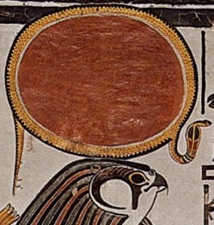Ra (Re) – The Egyptian Red Sun


Ra (Re) the Red Sun
Apr 5, 2010
A hazed red Sun, planetary chaos and a solar system besieged by dust and debris.
The Egyptian Sun god Re was typically represented as a sun-disk, or as a falcon-headed man wearing a red sun-disk on his head. Such imagery points to the god’s solar character. The following epithets present traits which are consistent with the life-giving properties of the Sun experienced today.
‘Re is the great light who shinest in the heavens
Lord of all lands…praise Re when he riseth at the beginning of each day.
Thou passest over the sky, and every face watcheth thee and thy course,
for thou hast been hidden from their gaze.
Thou dost show thyself at dawn and at eventide day by day.’
Re’s solar disk features heavily in Egyptian art and there exist numerous orbs adorning every monument, tomb, and temple wall throughout Egypt. They are also carved on stela and statues, painted on coffins and sarcophagi, as well as on scrolls of papyrus. They are even incorporated into Egyptian jewellery. Since the Sun was the primary source of life, such ubiquitous representation is only to be expected. However, there is something unusual about the way the Egyptians represented our nearest star that is incredibly revealing when considered alongside planetary chaos. Re’s most basic form consisted of a simple red disk. Why was this? Why not portray the Sun as it appeared?
The Sun is a blinding, golden-yellow disk with emanating rays – a ball of glaring, golden light. A red disk is drab and lifeless by comparison, and yet Egyptian art reveals not one single golden glaring Sun with a complete 360° sweep of sun rays. A perplexing situation, especially when considering that gold was the flesh of the gods and Re was the Sun god par excellence as epitomised in the godly pharaoh’s title sa re, which means ‘offspring of Re’.
Whether Velikovsky’s Comet Venus was the largest ‘volcano’ in the solar system, spewing out countless tons of sulphurous gas from its many thousands of volcanic vents, or Mars was disturbed from its orbit to undergo a catastrophic transformation, the result of any cosmic catastrophe would have been the release of immeasurable quantities of debris, dust and gas.
This debris eventually settled down into the plane of the ecliptic where it impacted the planets, the Moon, or fell into the Sun. To understand the effect that a stream of dust and gas 93 million miles long had on the Sun’s appearance, we need look no further than the art of the Egyptians. Their portrayals clearly reveal the red haze that surrounded our Sun. The Egyptians carved, drew and painted a red Sun because all they ever experienced was a red Sun. Furthermore, if the duration of Egyptian dynasties is anything to go by, our Sun was hazed red for an incredible 3,000 years.
The supposition that ancient cultures only experienced a diminished red Sun is both profound and exciting. It allows us to take much of the art and many seemingly bizarre beliefs at face value. Not the least being the fact that a hazed Sun means there was no glare, so they were able to look directly at the Sun without being blinded. This led to naked-eye observations of electrical phenomena such as coronal mass ejections (CMEs), flares, and prominences.
The image on the right at the top of the page depicts an Egyptian Sun encircled by a yellow royal uraeus serpent which was known to spit fire and venom at Egypt’s enemies. The image on the left was taken by SOHO and can be used for comparison, providing some idea of how the Sun appeared in a world dominated by cosmic catastrophe.
The cobra is a symbolic representation of vicious CME’s ‘striking out’ several times the diameter of the Sun at sungrazing cometary bodies: snakelike CME’s protecting the body of Re by spitting fire at Egypt’s enemies. In ancient times, those eruptions might have been observable on a daily basis and perceived to be a perennial battle against the forces of evil.
Regarding the association between CME’s and comets, Stephen Smith commented in a previous Picture of the Day:
‘Comet NEAT swung close by the Sun in 2003, apparently initiating a CME eruption that appeared to impact the comet. Astronomers at the time discounted any relationship between the two events because of the size differential between the comet and the Sun.
However, several other sungrazers have been associated with violent flares. One event can be a coincidence, two can be long odds, but three or more cannot be dismissed as mere oddities’. (see here.)
Regarding comet 96P/Machholz:
“It did not rapidly dissipate, however. Instead, its intense charge differential caused a gigantic CME to discharge from the Sun (see YouTube clip here), blasting out for millions of kilometers.”
The yellow coronal ring encompassing the snake represents the highly charged million-degree corona of the Sun, bursting through as a yellow ring due to its 20 million degree temperature. Gold really was the “flesh of the gods,” as bursts of golden energy were also observed emanating from the body of Re, as in the image above.

Egypt today has one of the most sunniest and driest climates in the world. Its sunsets and sunrises invoke thoughts of serenity and are a sight to behold. In total contrast, the ancient Egyptians believed Re’s daily path across the sky was fraught with dangers.
It was believed that the setting Sun prompted a perpetual nightly battle with the demons of the underworld. It was a doomsday scenario, and they believed that the Sun might not shine the next day.
The fighting aspect of the Sun is also played out on Mesopotamian cylinder seals. The ‘dispenser of divine justice,’ the Sun god Utu/Shamesh, is shown (right) with fiery solar ‘rays’ (CME’s) emanating from his shoulders. He also holds a pruning-saw. He is depicted cutting his way through the eastern horizon to again rise victorious. On some seals the snakelike shoulder rays end in stars, indicative of CME’s zapping space debris.Upon consideration, a red Sun at war opens a window to many ancient enigmatic beliefs.
Contributed by Gary Gilligan
See more on the Ancient Egyptian Red Sun here.



